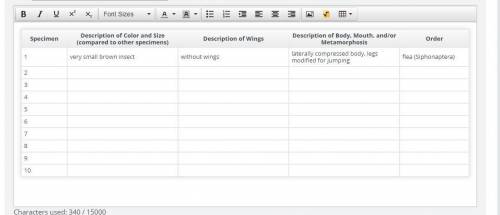
Biology, 11.01.2021 01:00, winchester729
Question 2
Now follow these directions to classify the insect specimens. Start by putting on your gloves and goggles. Then, using the forceps, remove all 15 insect specimens from the jar and put them in the Petri dishes.
Be very careful when removing the insects. Wings and body structures can be easily damaged. Choose 10 insects that you want to classify using the dichotomous key, and put the remaining insects back into the solution.
The dichotomous key that came with the Edmentum lab kit has descriptions and “refer to” numbers. Start at Space 1, and determine whether your specimen has wings. Jump to the “refer to” space to further classify the organism. Continue until you reach the insect’s order. If you’re not using an Edmentum lab kit, follow the instructions for your specific dichotomous key.
Now follow these steps to further classify each specimen. Write your notes in the chart using the exact wording from the dichotomous key. An example is given in the chart.
Use the magnifying glass to identify the body parts of each insect, such as the mouth or wing structure. Use the microscope on the lowest or second-lowest setting to observe the body parts of small insects.
Place the insect in the petri dish lid, and then place it on the microscope. (The bottom part of the petri dish is too tall to fit under the microscope. Adjust the upper microscope light instead of the base light. Then move the dish around until you can see the specimen.)
In some cases, an insect’s metamorphosis will determine its final order. Use credible websites to look up the metamorphosis of insects belonging to different orders, and match your specimens accordingly.
After you have studied all 10 insects, make sure your classification chart is complete and that you have used the exact wording from the dichotomous key.


Answers: 1
Other questions on the subject: Biology

Biology, 21.06.2019 12:30, dontcareanyonemo
A17-year-old primigravida is admitted in early labor. her cervix is 2 to 3 cm dilated and 100% effaced. the fetus is cephalic, and the presenting part is at –1 station. her membranes are intact. the patient is holding her boyfriend's hand tightly and breathing rapidly with each contraction. she tells the nurse in a shaky voice, "i'm so nervous. i've never been in a hospital before. i don't know anything about labor or if i can do this." what is an appropriate nursing diagnosis for this patient?
Answers: 1

Biology, 21.06.2019 19:40, TimaGarcia
What feature of cell theory is best demonstrated in the image
Answers: 1

Biology, 22.06.2019 01:30, netflixacc0107
Which of these best describes what occurs during cytokinesis? a) the chromosomes are separated b) the cell begins to divide by replicating the chromosomes c) the cytoplasm is divided between the two new daughter cells d) the nucleus opens to allow the chromosomes to enter the cytoplasm
Answers: 1

Biology, 22.06.2019 11:30, alyssahomeworkneeds
Graded assignment lab report answer the questions below. which combinations of substances resulted in a chemical change? for each metal that participated in a chemical change, write the type of metal it is, based on your examination of the periodic table. were there any metallic compounds that did not react with either the acid or the base? write the type of metal, based on your examination of the periodic table. make a general statement about the reactivity of the metals in this experiment.
Answers: 1
Do you know the correct answer?
Question 2
Now follow these directions to classify the insect specimens. Start by putting on your g...
Questions in other subjects:

Mathematics, 03.12.2019 19:31

Physics, 03.12.2019 19:31

History, 03.12.2019 19:31



Biology, 03.12.2019 19:31

History, 03.12.2019 19:31

Health, 03.12.2019 19:31







